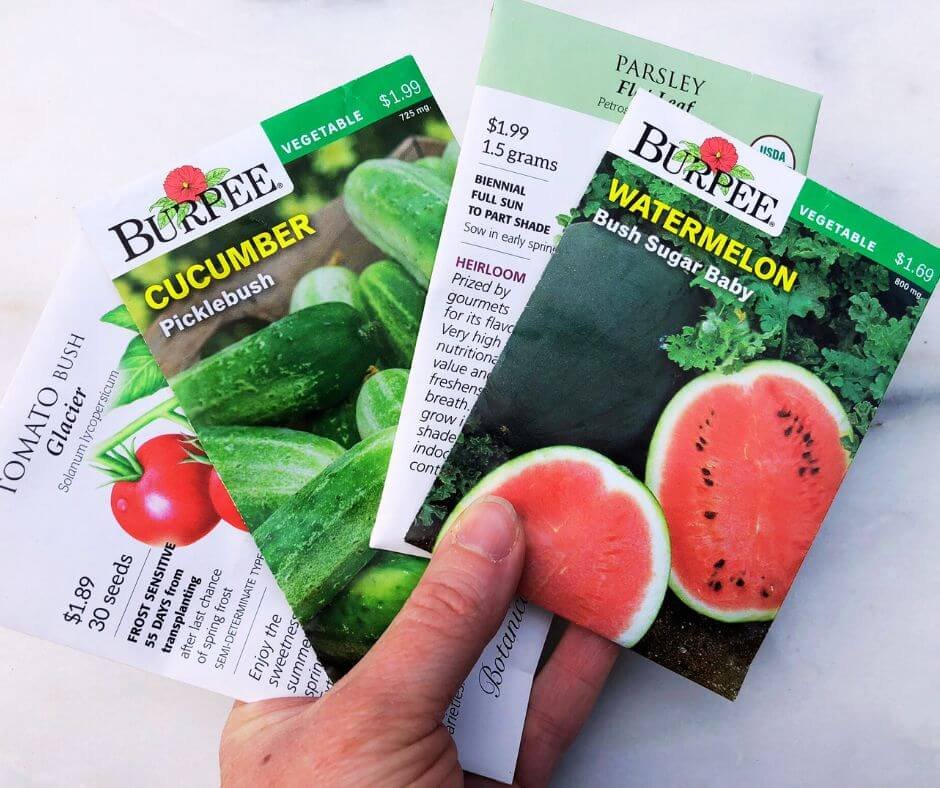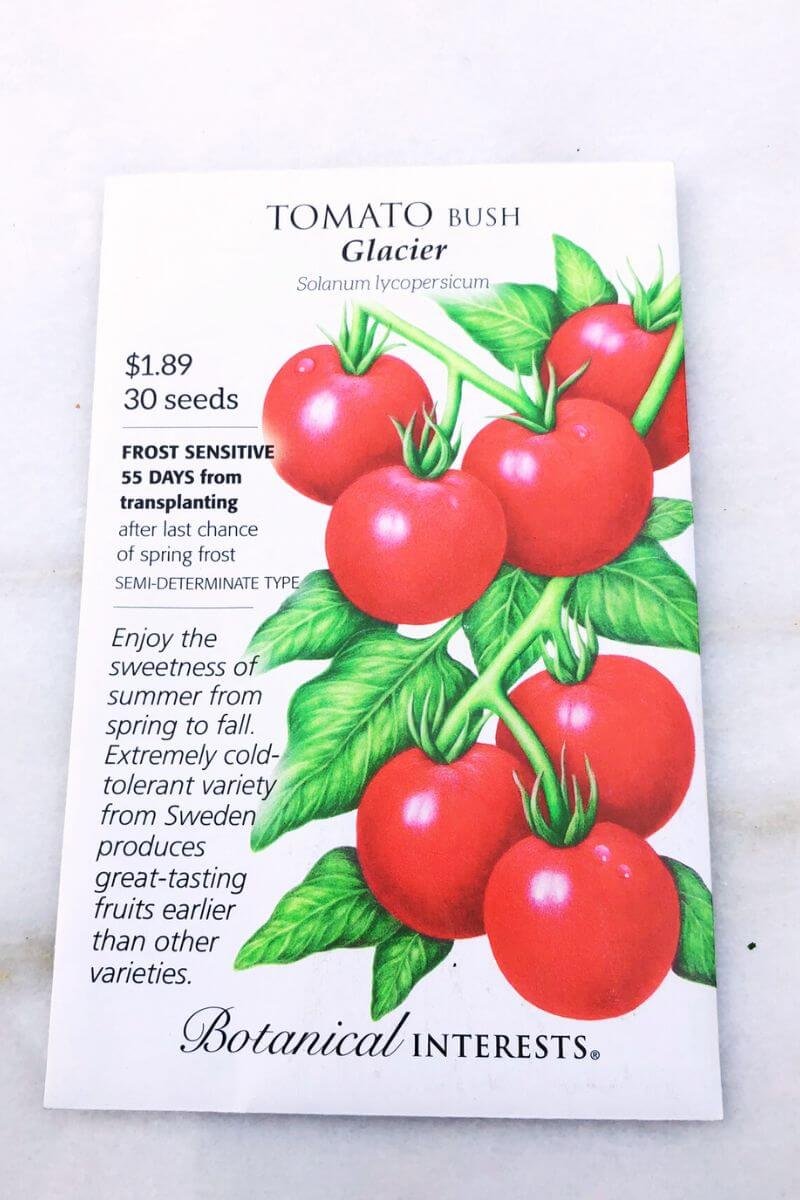How to Read a Seed Packet
Understanding how to read a seed packet
Updated 6/14/25
Understanding how to read a seed packet can be tricky if you are new to gardening and are looking to get started. But if you want to be successful at seed starting, mastering this is the first step.
A seed packet can have a lot of useful information, but it can also be overwhelming at first glance. And every company has its own way of presenting the seed’s information; some give more helpful and useful tips than others.
So if you are not experienced at reading the information, you might not be sure what you are getting and how to plant it.
That’s why we are going to take an in-depth look at seed packet information and break down how to read a seed packet so you can have a flourishing plant and garden.
The items listed are accompanied by affiliate links, meaning I earn a small commission if a purchase is made through my links. This has no impact on the cost to the consumer. I link to products this way whenever possible, and it has no bearing on the products I choose to review or recommend.
Table of Contents Hide
How to Read Seed Packets
A seed packet has useful growing tips and information on both sides of the packet. It is important to read both sides so you know what type of seeds you have and how best to grow them.
The seed packets that I will use as examples are from the companies Botanical Interests and Burpee.
I like to use these two companies because they pledge that they do not sell genetically engineered seeds or plants.
Reading the Front of the Seed Packet
Let’s start with the front of the seed packet and go over its instructions.
Here are the categories of information that are listed on the front of these packets.
Plant Name
You will see the common name of the plant as well as the variety or cultivar at the top of these seed packets.
In this case, it would be a Glacier Tomato Bush (Solanum lycopersicum) and Flat Leaf Parsley (Petroselinum crispum).
Plant Photo
You should see a photo or illustration of what the plant will look like when it is mature.
This should give you a good indication of what you should expect.
The Seed Company
This is the company that harvested and distributed the seeds.
Price/ Weight/Quantity
The price is usually listed at the top. The number of seeds per package will vary based on the cultivar. Some of the packages will list the number of seeds or list the amount by weight.
You can see that the tomato seeds packet lists that it contains 30 seeds in the packet, and the parsley is by weight and is 1.5 grams.
Plant Description
There is a brief description on the front that highlights the unique attributes and best qualities of the plant.
For example, the tomato seed packet mentions that it is extremely cold-tolerant and produces fruits earlier than other varieties.
The parsley seed packet mentions that parsley is very nutritious and freshens breath, and will grow in part shade and indoor containers.
Which Varieties are USDA-Certified Organic
If you see USDA Organic on your seed package, it lets you know that the seeds were grown without chemicals.
You can see that my parsley seeds are organic, but my tomatoes are not.
When to Sow
On the front of the seed packet, the company gives a quick answer to when you need to plant.
More detailed information is given on the back.
Here is the front of a Burpee Bush Sugar Baby Seed Packet.
Here is an example of the back of a Burpee Seed packet. They include a map with a timeframe of when seeds should be planted.
Reading the Back of the Seed Packet
While the front of the seeds packet gives you a good amount of knowledge about the seeds you are getting, the back of the package gives you the detailed seed packet instructions needed to help plant and grow your seeds.
Here are the categories on the back of the package.
Seed Packet Plant Tag
Every Botanical Interests seed has a plant tag that details how to sow the seed for the best germination and growth.
You can cut this out and use it to mark your plant in the beginning.
Plant Name
The name of the variety or cultivar is listed on the plant tag.
Seedling Illustration
This picture will give you an idea of what the seedling will look like, so you can distinguish it from weeds.
Days to Emerge
This is an approximate number of days from sowing your seed until the seedling comes up.
The time frame varies for every plant, and remember that it is an estimate.
Seed Depth
This is how deep you will plant or sow the seed to get the best germination.
This depth is the same for inside and outside sowing.
Seed Spacing
This is the amount of space you should use when planting to avoid crowding.
Row Spacing
This is in reference to the distance needed between rows of the same variety.
This allows the plants to receive proper sunlight and air circulation and gives the plants enough room to grow.
Thinning
Thinning refers to the removal of extra seedlings after germination to the recommended number and spacing so that seedlings can grow and develop.
Maturity
This is an estimate of when your vegetable, herb, or fruit will be ready to harvest. Some companies also refer to it as days to harvest.
Date Seed Sown
This space is blank so you can record when you’ve planted your seeds.
How Much Will This Packet Sow
On the back of the seed package, there is another description that highlights the plant's features as well as gives you an estimate of how much you can anticipate sowing from your seeds.
For example, the packet of tomato seeds will yield approximately 24 plants indoors, and the parsley packet will sow up to 154 feet.
The number of seeds you choose to sow will depend on the germination rate. It's advisable to plant a few extra seeds to ensure the desired number of mature plants.
You can always thin out extra seedlings.
When to Sow Outside/ Direct Sowing
This will tell you the information you need to sow your seeds directly outside.
It will tell you if it is recommended to do this way, give an estimate of time after the last frost date to plant, and a recommended soil temperature.
When to Start Inside
Again, pay attention to the sowing directions because some seeds will do better if they are started indoors.
If you are going to be starting your seeds indoors, it will give you an estimated time to start them and recommend the best time and conditions to transplant.
RELATED: Cultivate Success: The Ultimate Guide to Growing Parsley Indoors
Special Germination Instructions
Some seed packets will have this section. It provides you with tips to improve germination.
For example, parsley seeds do best when you soak the seeds in water for 12-24 hours before sowing.
I tested this; find out if soaking seeds before planting is really important! I was surprised by the results.
Make sure you follow these instructions if they are included in your seed packet.
Types of Seeds
Open-pollinated
An open-pollinated seed results from self-pollination, pollination from insects, birds, wind, or other natural means.
The seed comes from the parent plant.
Hybrid
Hybrid seeds are when varieties are cross-pollinated so they can have specific features.
They are bred through a controlled method of pollination. Usually, two different species or varieties are created by human intervention.
Heirloom
Heirloom seeds are a variety that has been grown for generations. They are open-pollinated.
Non-GMO Seeds
Non-GMO seeds are seeds that are not genetically modified.
Organic Seeds
They must meet USDA standards and be grown without harmful chemicals. They will also be non-GMO.
Lot Number
It should have the lot number listed on the bottom.
This helps the grower be able to identify the batch that the seeds came from in case there are any issues.
Packed For/Sell by Date
You will see a date listed when it was packed and a sell-by date.
Fresh seeds will always do the best and have the highest success rate.
It is best to use them by the date listed on the seed package. However, seeds can be saved to plant at a later date.
To preserve them, store them in an airtight container to prevent moisture from getting in and keep them dry and cool.
Some Tips When Buying Seeds
Research the companies and understand their growing practices
Make sure the growing conditions fit your garden and the situation
If you aren’t sure how to grow something, make sure there are clear directions
Experiment with different varieties
There is a wealth of information on the seed packet that will tell you how to sow your seeds and what conditions need to be met.
Don’t be intimidated by the information, it is there to help you. The more you get customized to the lingo and growing conditions the easier it will be.
Gardening from seed can be very rewarding. I hope that you now feel confident about reading a seed packet and can identify and pick out the variety that is right for your garden.
I recommend keeping notes about what you planted and how it fared so you can determine what grows best in your garden and easily make your choices in the future.
If you still have questions about reading a seed packet, drop them below in the comments, and I’ll be happy to help!
Pin for Later>>























